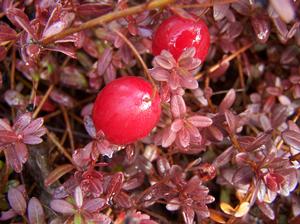
Vaccinium macrocarpum in autumn
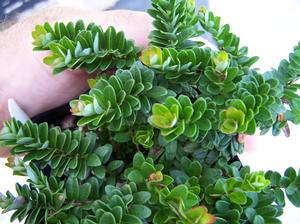
The very dwarf Vaccinium macrocarpum 'Hamilton'
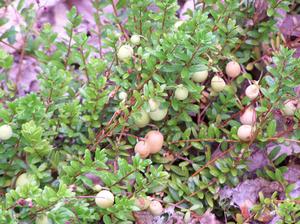
Vaccinium macrocarpum 'Pilgrim' developing cranberries
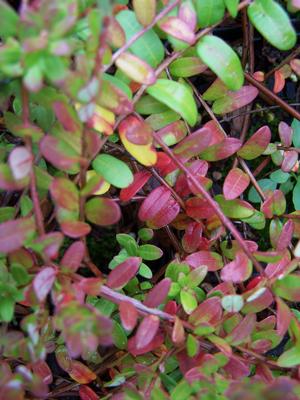
Vaccinium macrocarpum red and green mix in mid September
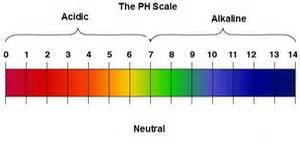
Ph Scale
Vaccinium macrocarpum - Our Native Cranberry
Vaccinium macrocarpum, the beloved Cranberry is a most beautiful yet underutilized shrub in gardens. Even folks who grow much of their family's produce seem to ignore this remarkable, easily cultivated shrub. Cranberry, often associated with extraordinary Cape Cod which is actually one of its significant native habitats is in the family Ericaceae. Vaccinium macrocarpum is related to blueberries, rhododendrons, heaths and heathers in this wide-ranging, exquisite family. Vaccinium macrocarpum also shares Massachusetts' Cape Cod with another near relative in the Ericaeae, bearberry (Arctostaphylos uva-ursi).
Cranberry's small oval to elliptical leaves on this easy-to-please ericaceous shrub turn rich red on long wiry stems as the temperatures cool. Stems overlap and thicken into "rugs" about four to six inches deep, maybe a little thicker in time. They are modestly tousled, the smallness of the leaves providing softness, refining overall appearance.
Small pink to white flowers occur in the axil, where leaf meets stem. They are four-petaled and tiny. Though cute upon close inspection they are not significantly ornamental due to their small size. The flowers emerge in late spring. They set the stage for the real show.
Fruits begin their reign as glossy greenish white marbles, small at first and slowly increase girth from one half to three quarter-inch in diameter. Becoming infused with pink berries finally mature deep bright saturated red, large and showy orbs in late season. They stud the small elliptical green leaves. As the season cools and the days grow shorter the green leaves become a mix of green and red. Often the mats become entirely ruby before the winter solstice. Usually evergreen the shrubs hold onto their leaves through the winter. The fruits, as edible as they are ornamental, stud the dark red-maroon leaves like jewels.
Vaccinium macrocarpum will make a beautiful piece of patchwork in a quilt of heaths and heathers, is grand with a close cousin, lingonberries (Vaccinium vitis-idaea) and dwarf conifers. It will also develop into a striking ground cover planted en masse.
These sun-lovers relish a sandy loam with some fertility. Vaccinium macrocarpum are acid-loving. Therefore, a planting situation must be on the left of center on the Ph scale but not too extreme, 5 on the scale would be the number to achieve. Most of us in the northeast won't have to be too concerned as our soils trend acid. Soil moisture should be relatively constant. Cranberries will appreciate the addition of organic matter to a sandy loam. This will not only feed the plant but also help maintain soil moisture longer between rains.
Cranberries are not plants that will be happy in the deep south. Their USDA cold hardiness range is 2 (-50F) to 6 (-10F). They may survive zone 7b (-5F) but zone 8 and higher will be too hot, an anathema to cranberry's cooler requirements. Spring planting is best.
Contrary to popular myth Cranberry does not thrive in perpetually wet bogs. Constant inundation will drown and rot this shrub. The misconception comes from a technique employed by growers. Fields or bogs are purposely flooded to harvest the large, showy fruits. Showy fruits float allowing for easier harvest.
'Pilgrim' is a good producer of culinary quality cranberries. 'Hamilton' is purely ornamental. Genetically very dwarf 'Hamilton' forms nearly flat shrubs composed of fat, dark green glossy leaves. Because the foliage is set oppositely and the internodes are very short the appearance is that of a most handsomely textured mat which follows the contours of the ground. Leaves turn ruby-maroon in autumn. This rare and astonishing form is small enough for a trough. It is certainly a gem which should attract rock gardeners and collectors alike.
If you have ever made blueberry cornbread then replace half of the blueberries with cranberries. Augment the recipe with a little additional sugar to offset the tartness of the cranberries. It's a real treat. Use buttermilk for the liquid ingredient. The blue and red is beautiful in the yellow cake; the buttermilk adds richness. Follow this recipe for an exceptional holiday cranberry sauce:
Cranberry Compote with Apple & Orange
1 12ounce bag fresh cranberries, picked and rinsed
2 apples, peeled and diced
1/2 cup brown sugar
1/2 cup orange juice
1/4 teaspoon allspice
pinch of salt
1 orange (2 clementines)
Directions: Stir together cranberries, apples, brown sugar, orange juice, allspice and salt in a large saucepan. Place over medium heat and bring to a simmer, stirring often. Continue cooking, stirring often until the cranberries have popped and the mixture thickens, about 5 minutes. Remove from heat.
Meanwhile, zest orange (we use 2 clementines as an alternate). To supreme the orange: Cut skin and white pith off the orange. Cut between membranes to remove individual segments, working all the way around the orange. Gently stir the zest and orange segments into the compote. Discard orange membrane and peel. Cool compote completely, about 2 hours.
Happy Holidays.
penned by Wayne Paquette, March 2015